In 1954, as the centenary of the end of the Crimean War approached,
my uncle John Alldridge produced a series of articles for the
Manchester Evening News which vividly described that campaign.
In this article, the words are his; the choice of illustrations is mine.
Jerry F
The Charge of the Light Brigade
The few Russian squadrons that had escaped the Heavy Brigade and were racing downhill towards Balaclava were met by the steady volleys of the 93rd Highlanders.
Holding its fire until the enemy was only 150 yards away, the immortal “thin red line” rose to its feet and shattered them with a devastating burst that sent them scampering after their comrades until they were pouring back right across the front of Cardigan’s Light Brigade, who could nothing but sit there in their saddles and watch them whirl by like a scurry of autumn leaves.
And so, for the second time in this ill-fated campaign, a huge enemy force was allowed to get away almost undamaged.
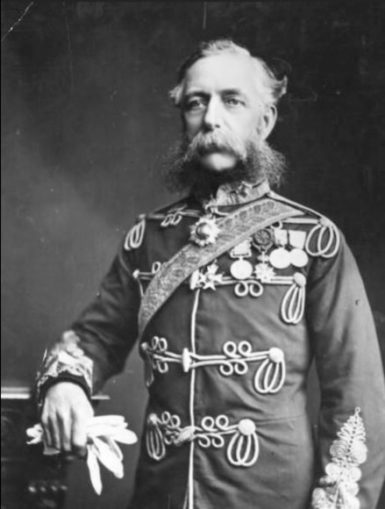
James Thomas Brudenell (1797-1868),
Unidentified photographer – Public domain
Sitting there fuming with rage and humiliation, Cardigan’s troopers could see the Russians re-forming behind their guns in the neck of the narrow valley a mile and a half in front of them.
But perched up in his look-out above the plain, surrounded by his staff and assorted hangers-on, the British commander-in-chief could see something else.
The Russians, still in possession of the Causeway Heights and astride that and the road, were preparing to carry off the guns left behind by the Turks in their flight.
To Raglan, veteran of Waterloo and brought up in the tradition of Wellington who “never lost a British gun,” this was unthinkable.
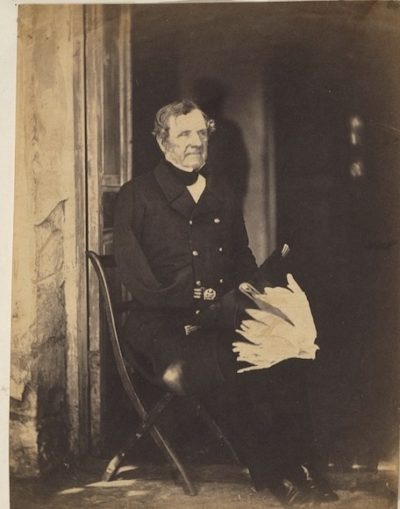
Field Marshall Lord Raglan, Crimea,
Roger Fenton – Public domain CC BY-SA 2.0
He detached an A.D.C. to ride with a message to Lucan, ordering the Light Brigade to save the guns.
That order, issued by Raglan at about a quarter to eleven, became for many years the subject of acrimonious debate.
For it was not written by Raglan himself! It was written by Airey, his Quartermaster-General, a man in whom Raglan had unlimited confidence and who sometimes presumed on that confidence.
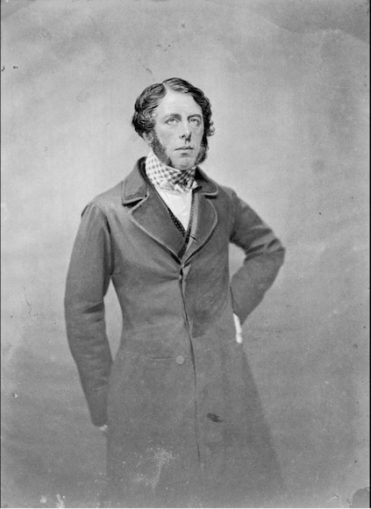
Major General Sir Richard Airey,
Unknown photographer – Public domain
But Airey afterwards insisted that it was dictated to him by Raglan. And Lucan – who had to carry the responsibility of that charge for the rest of his life – protested that it was first given verbally by Airey to the A.D.C., Nolan, and then hastily confirmed in writing.
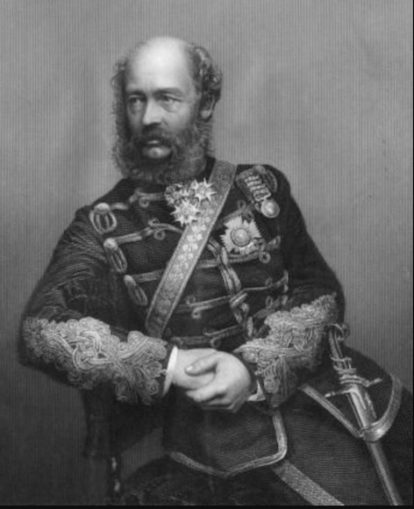
George Bingham, 3e comte de Lucan (1800-1888),
D.J. Pound engraving after John Watkins – Licence CC BY-SA 2.0
That historic order, which condemned to death or serious injury 247 gallant men and 475 horses out of an effective strength of just under 700, and in 20 minutes destroyed the finest light cavalry in Europe, is preserved in the Royal United Service Museum.
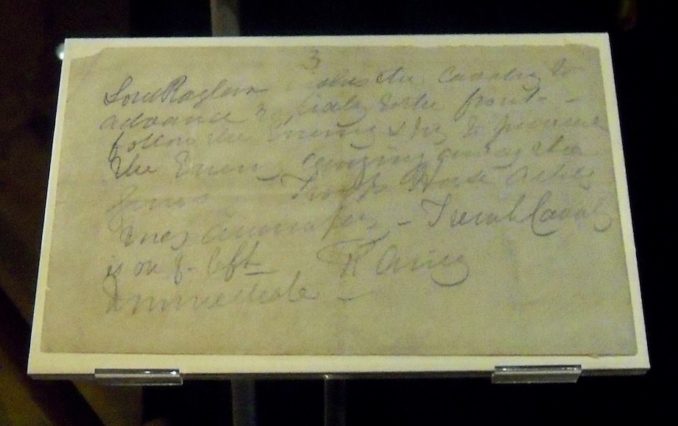
The written order which lead to the Charge of the Light Brigade in 1854,
Jack1956 – Licence CC BY-SA 4.0
Scribbled in pencil on a sheet of paper of poor quality, thin and creased, the writing is as clear, the meaning as ambiguous as it must have seemed to Lucan reading it on that fatal morning almost 100 years ago:
“Lord Raglan wishes the cavalry to advance rapidly to the front, follow the enemy, and try to prevent the enemy carrying away the guns. Troop horse artillery may accompany. French cavalry is on your immediate left. Immediate. R Airey.”
Now to Raglan blessed with a bird’s eye view of the whole battlefield, it must have seemed perfectly clear. The enemy specified were the Russian artillerymen on Causeway Ridge to Lucan’s right: the guns the captured Turkish guns they were already dragging away.
But the commander-in-chief was not to know that Lucan, concealed in his grassy hollow, could see nothing of this. We can hear him still, sitting there, mid-way between the Heavies and the Light Brigade, reading that confused message, stuttering: “Attack, sir! Attack what, sir? Guns . . . what guns?”
If the order was a mistake, the choice of the man to carry it was stark tragedy.
Captain Lewis Edward Nolan was a cavalry fanatic who firmly believed in the omnipotence of that arm. Moreover, like most cavalrymen, he was raging mad at the incompetence of Lord Lucan.
Whether he knew what he was doing or whether what followed was just a piece of dramatic bravado we shall never know. For a few minutes later Nolan was dead.
But what Lucan saw and heard, with ill-controlled fury, was this impetuous, impertinent young A.D.C. rising in his stirrups and shouting, with all the contempt he could muster:
“There, my Lord, is your enemy: there are your guns!”
And with quivering outstretched hand he pointed in the wrong direction – not to the Causeway Heights on the right, but straight in front to the Russians securely in position behind their guns at the end of the North Valley.
So the Light Brigade was committed. Though every man from Lucan down to the youngest trooper knew that “someone had blundered,” there could be no disobeying an order.
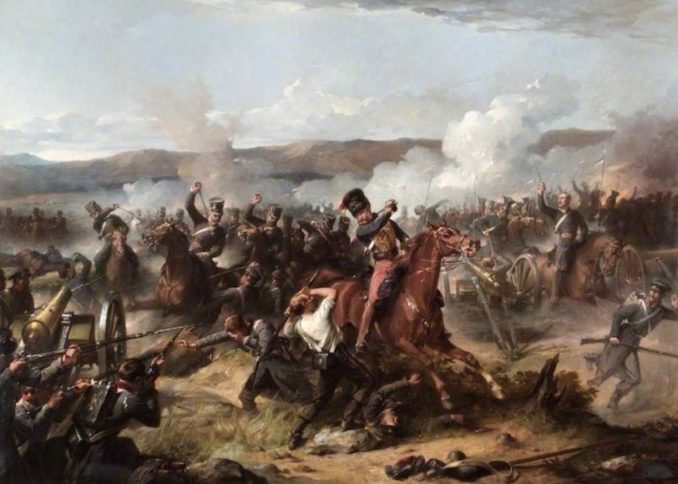
Thomas Jones Barker, The Charge of the Light Brigade,
https://en.wikipedia.org/wiki/Thomas_Jones_Barker – Public domain
In flagrant disregard of reason a force of 600 horsemen equipped with swords and lances was to gallop down a valley over a mile long at the end of which sat facing them a firmly entrenched force of cavalry and infantry behind 12 guns, while on either side were more batteries and numerous lines of riflemen.
Every schoolboy knows what happened then. How the Light Brigade, showing matchless courage and impeccable discipline, advanced straight to its front, never swerving from its futile target until the survivors reached that gun-line.
But there were isolated incidents which, even at this distance in time, light up like gun flashes the battle-smoke of confusion that shrouds that 20 minutes of inspired lunacy.
There is Lord Paget at the head of his Dragoons, smoking an excellent cigar which, he is surprised to notice, lasts until he reaches the Russian guns.
There is Lord Cardigan, enjoying his finest hour, right out in front them all, “as steady as a church,” riding in all his glory of gold lace and flowing whiskers, ordering back presumptuous riders who dare to race him.
As he methodically cuts down his first gunner he sees riding towards him a Russian officer with whom he had been friendly in London. It is an embarrassing moment. But of course they politely avoid each other.
There is Nolan, realising his error too late, wheeling frantically out of line right across the front of the Brigade shouting something unheard in the roar of the guns.
Nolan, killed by a shell in that terrible moment of truth, his horse carrying his stricken body back through the advancing lines of lancers and dragoons, which open to let him pass.
Then bursting from that body, “a strange and appalling cry, a shriek so unearthly as to freeze the blood of all who heard him.”
And then, at last, he who had started them off into the Valley of Death falls from the saddle dead.
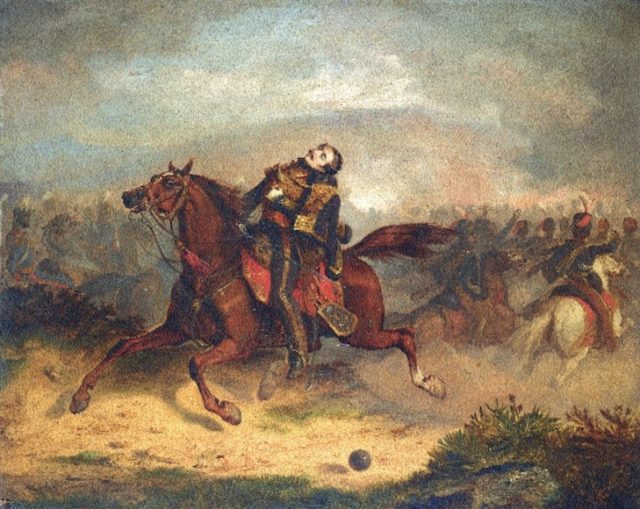
The death of Captain Nolan at the Battle of Balaclava,
Thomas Jones Barker – Public domain CC BY-SA 2.0
“Then they rode back. But not, not the Six Hundred.”
Lying in a corner of the tent of the Russian commander, General Liprandi, Private Wightman of the 17th Lancers, wounded in four places, was being interrogated.
“Come now,” coaxed the jovial Russian. “What did they give you to drink?”
“You think we were drunk? I tell you if we had so much as smelt the barrel we would have taken half Russia by this time.”
And Lord Cardigan, who had carried himself that day “like a hero of antiquity”?
My Lord rode back to his yacht, had a bath and a bottle of champagne with his dinner, and went to bed.
Next Episode: Inkerman – the soldiers’ battle
Text:
The British Newspaper Archive (www.britishnewspaperarchive.co.uk)
The British Library Board
© Reach PLC
© Jerry F 2022



